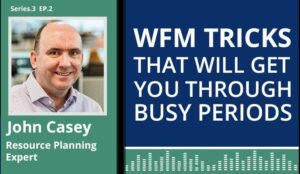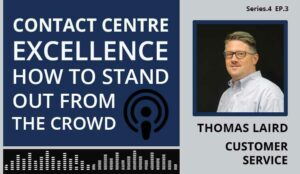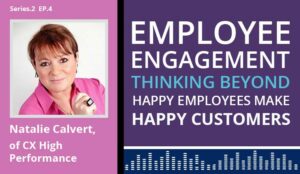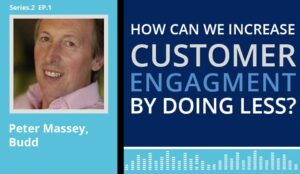The Contact Centre Podcast: Series 3 Episode 2
In this episode, John Casey, a Resource Planning Expert at CCplanning, discusses how to prevent and manage periods of unexpectedly high contact volumes in the call centre.

As part of our discussion, we also talk about factoring absenteeism into our forecasts link between scheduling and employee engagement, as well as sharing more tips that will help you to steady the ship when things get a little crazy!
To listen to the podcast directly from this web page, just hit the play button below:
The Contact Centre Podcast – Episode 14:
Wfm Tricks That Will Get You Through Busy Periods
This podcast was made possible by our sponsor, Genesys.
Podcast Time Stamps
- 02:20 – Reducing Absenteeism
- 07:02 – Enhancing Staff Schedules
- 16:58 –The Role of the Resource Planner
- 19:56 – Creating Standard Operating Procedures
- 24:07 – Tips for Intraday management
Here is a Transcript to the Podcast
Charlie Mitchell: So when things are really busy, it’s important to keep absenteeism to a minimum. But, before we work on lowering our absenteeism, should we be forecasting it and applying it to our staffing plans?
John Casey: Yes, Charlie. I think the answer to that is absolutely. And I think if we step back and we look at the planning cycle that’s often talked about with forecasting, scheduling, and reviewing, anything you can measure, you can forecast. So we do have to step back and we need to say, well, a) are there any trends? And I mean this is December. And to be honest, in the last four to six weeks, we’ve been seeing a lot of bugs in the call centres, particularly over here in Ireland at the moment. And it’s really let us step back at the client I’m working with and go, well, what’s going to happen? Can we predict the sickness? Can we predict where we’re going?
But I think one thing we often don’t look at is the influence we have ourselves on it. I mean, people have traditions and people have time, so they like to do things, and often you’ve got that link between rejected requests and sickness and that’s something you can really step back and have a good look at historically and build in to say that for every 10 holidays we reject, we actually see a bout of absence, maybe not the same person, but within the workforce.
John: So there’s a lot of angles we can take to step back and say if we can measure something, look at it after time, we can start to see behaviours and start forecasting that.
Charlie: I think one of the key reasons why I went straight into absenteeism is that it can so often be the cause of busy periods. So knowing the tricks of how to handle it for resource planners can be very important.
So with this in mind, I wanted to talk a little bit about how we can reduce absenteeism as well. And there’s a key principle in WFM around the Power of One. I was just wondering if you could tell us a little bit more about this and possibly why advisors should know about it.
John: Well, I think advisors often don’t know the impact they can actually have. I mean, it could be sitting as one member of staff in a 500-, 600-, 700-seat centre and you get up in the morning and you feel a bit croaky. You feel a bit under the weather. Perhaps you overindulged the night before, and you go, “They’ll never notice me.” But the reality is each person, extra, who doesn’t turn up has a bigger impact on service than the person before them to call in absent.
So the first person, absolutely we can all cope plus or minus as a person, we’ll still meet service, we’ll still do well, but the second person will start to have an impact. The third person, the fourth and then suddenly you get to the stage where each subsequent person could be causing you three, four or five or even more percent on your service level because it’s the cumulative effect.
So I suppose what agents don’t often realize is that anonymity that they think they are just one person within the organization, because in this day and age, where everybody has a cost and there’s no money and we have to do everything as low cost as we can, there’s probably not much fat built into our staffing plans any more. So then that one person can really, really make an impact. I don’t think agents often realize that. And I suppose it’s not just full days off. It’s things like breaks and lunches and going late or not going. And we had a case yesterday with the client that I’m working for where we’re absolutely right staffed but the service level was just inexplicably low. The people we had should have been enough, and it was little things like going offline to do some callbacks, going offline to perhaps do a bit of processing of post or get the letters out to the customers.
But when three or four people do it at once, that absenteeism can just cause a queue to form, and what a lot of us know from harsh reality, is once you get a queue, it’s very hard to clear it. It’s easier to build a queue than it is to get rid of a queue of customers. And you think it was only me only took five minutes or only took 10 minutes. But again, we come back to the cumulative, and the Power of One maybe isn’t the true thing, but it’s the power of a few can make a huge difference.
Charlie: I think it’s interesting that you say that, particularly with lateness and the staff think, “Oh, I’m just five minutes late. What harm could that do?” But showing them what it could do, I think is a really great thing. And to reduce lateness as well, I think scheduling and wider resource planning could be a really great thing. And do you think that the link between employee engagement and staff schedules is often under-appreciated?
John: Yeah, I think it absolutely is. I think if you treat the people in such a way that you regulate, and you use the stick, and you’re watching the screens, and you’re going, actually human behaviour repays you with what you deserve for some of that. But when you sit and you explain to people and you show them how queues fill up, how customers get answered, the fact that they’re not there means certain calls don’t get answered and then the next set of calls then back up behind them. And by the time you work through the customers or the customers are waiting a lot longer and it becomes like a rolling stone, gathering moss, gathering clay as it goes, down the hill, and the effect becomes a lot, lot greater.
Now one example of a centre I went to recently, they don’t schedule breaks and that can cause you to take a big breath back, going how do you cope with no breaks? But it’s very clear to the staff that they’re allowed 30 minutes a day, that will be watched and that would be disciplinary if they go outside that.
But if you’re a smoker and you want to take four seven-and-a-half-minute breaks or if you’ve got something on in a one-off occasion and you want to run a break into your lunch or even leave 15 minutes early, subject to calls being under control, we actually leave that in the hands of the staff. And as soon as we start saying, “You decide when you want your tea break. You do what’s right for you,” we actually see them reacting, and sometimes staying longer because it’s busy, sometimes going, “Well, it’s quiet, so look, I’ll go make tea for everyone and take me a few minutes.” And you get different behaviour and I’m becoming a convert.
So to go back to what you were saying, Charlie, once people get shown the impact, the impact they have in clearing queues or how easy a queue comes, but also treat them like adults. Sometimes it’s a big helper for the intraday outputs
Charlie: I think the example with the break time there is fascinating. I’ve never heard of anything like that within the contact centre industry before. I think that’s often because scheduling can sometimes be viewed as almost as if it’s a game of Tetris, where you kind of design shifts and offer overtime to plug gaps. But should we in resource planning be thinking about engagement first and then how we can plug the gaps later?
John: Yeah, and I mean if we just go back to that example, I think what I’ve realized is, since we don’t know how long a customer is going to be with you, and if your average calls gets six minutes, well, five minutes before I take my break, I know by answering that phone I am almost certain to be late going on my break. And that call could just as easy last an hour or it could last six minutes because we don’t know what the question is.
So as any intraday analyst will tell you, there are always people going late and therefore coming back late and then others will go 20 seconds early and you just get this behaviour thing that comes up and down. So, letting them choose their times versus scheduling their times, if you’re the right size perhaps, and I’m lucky where we’re doing it’s not multi-site. The question is why not?
Charlie: These are really great things to improve engagement and over time that will help in the busy periods because if we kind of remove the lateness and the sickness and the other absence, that really will help. And I also think in terms of engagement, I’ve been thinking a lot about this recently, do you think that we need to kind of move away from “everybody works a five-day week of 37 and a half hours” and maybe experiment with some other ideas like the ones that you’ve just suggested?
John: Yeah. I think the five-day week is huge now in the US. Countries like Sweden are trying the four-day week. If you actually think about it and you look at call patterns and you look at customer demand, these Lego bricks have exactly seven and a half hours on the phone and can’t be plugged in to the call curve perfectly. But for some people, their outside interests, what they like to do, they’d be perfectly happy to work a couple of long shifts, if it meant that every Wednesday they could re-join their mates from school and play indoor football, or they could go to a class or a hobby, or go with their kids to something, and they’re perfectly happy to do that because it feels that work is going around their work, their life, and their life balance.
Now, once we start saying what every shift must be, seven and a half hours plus lunchtime and we have to be rigid, people then start, dare I say in the modern age, to resent and they almost see the schedule as being detrimental to their life and their life plans.
Everything you read knows about work–life balance and mental health, and bringing in my experience, my experience being back on the frontline in the last couple of months, it’s very much talk to people, explain to people and make them understand why you were putting schedules together in such a way, but also understand what’s important to them and their life and see how much of that can be built in.
Maybe you can’t give them every Wednesday night off, but you could give them three out of four or two out of four, and suddenly they’re getting better than they had. So when somebody comes and asks for something, I’m always going, try not to say no, try to understand, and maybe they don’t need a day off. Maybe they need a few hours off, but they feel the only way to get it is they ask for the day. Suddenly when you do need help, staff feel like they owe you something, they feel like they want to pay you back, and they’re more likely to say yes. So for me now, thinking about what makes a good planner, even if it’s numbers based, even if they have to be comfortable using numbers and building stuff up, what I actually think is empathy and communication skills are now on par with that, because customer demand is changing. It’s going very different to what we would have seen 15, 20 years ago and now we have to match a workforce – especially with Generation Z coming out, baby boomers and things like that, who don’t want the nine to five or the 12 hours or the rigidity. They want to enjoy life and there is a happy medium. So, as you say, employee engagement, planners speaking to agents, listening to agents, not necessarily saying yes but trying to understand the big picture, is probably the scheduling of the future.
Charlie: I think this kind of reminds me of, I saw a presentation of yours once where another tip that you suggested was asking advisors if there was one time period in the week that they would like to have off. Maybe like a couple of hours on a Wednesday or a couple of hours on a Tuesday where maybe their child has to be picked up early from school or their favourite TV programme is on. Is this something else that you would recommend to contact centres?
John: I think it doesn’t hurt and I think it’s one of the biggest things we don’t look at. You know, we get the same contract, often 24/7 contracts, even if we’re not open seven days a week, 24 hours a day, but we try to bring this, “you will work when we tell you to work”. When you ask, “why would people leave?” they’ll leave because of working conditions, they’ll leave often just because they feel, I can have a better work–life balance elsewhere.
But when you drill down and speak to people, there’s often one important thing, something that’s dear to their heart. As you say, whether it’s a TV show, whether it’s the chance to play indoor football, whether it’s to go with their child to a hobby that the child does, swimming class or whatever that might be. Maybe they’ve got elderly parents and by helping them one morning a week by taking them into town to do the shopping, that gives them the feeling that the company values them.
If you think about it, scheduling dozens, hundreds of people, there’s so many shift patterns out there, a little bit of accommodation in there might be a bit awkward. It might be a little bit more, but with our workforce management systems and the abilities to set up rules, it’s not going to compromise your coverage as long as you’re not giving everybody the shift they want to DIY themselves. So that if I could give you a block of two to three hours once a week that we will never schedule you or at least we won’t schedule you without having a discussion as a one-off. Again, you build that rapport, you build that sense of belonging to the company. Probably extend somebody’s life at the company by a few months at least, if not years.
And when you do need something from people, they’re more likely to say yes because they feel the company’s looking after them. It probably leads on to attrition and things like that and the cost of hiring people, so that it’s not just about the absence, it’s about keeping people that little bit longer. The call centre agent, three to four years may be a decent lifespan with a company. But if you could keep someone six months longer before they get that itchy feet, the savings as well to the business is actually so potentially high you might actually get a higher budget for more staff, which in turn will put less pressure on people like you to stay longer as well.
Charlie: Yeah, this is a really a great topic. I love that more and more contact centres are appreciating the link between WFM and employee engagement now. I just kind of maybe want to move on a bit more to what people would expect from a podcast about handling busy periods.
I want to talk a little bit about the importance of knowing when it’s key to make important changes. So a key skill as a resource planner is knowing when to hold your nerve when things get really busy. Do you think there’s a lot of danger in the kind of intraday management in making knee-jerk decisions?
John: Yeah. I mean, I think the biggest thing, Charlie, that you can do is move the problem. So we come in and we see a queue and we go and we do something like move lunches and move breaks. Well, the lunch and the break don’t go away. So you can actually end up overstaffed with people there and a little bit quieter than expected sitting around, and then at some point in the day you end up in a scenario where you’ve got a backlog of breaks and lunches and they have to happen anyway.
Similarly, with training, similarly with coaching, and one-to-ones, it’s the easiest thing in the world just to say, “Let’s cancel, let’s do it another day.” Then you get to the 27th, the 28th, the 29th of the month, and a team manager’s bonus depends on these things happening, and for some reason our customers have decided it’s a perfect time to call and we then end up with a complete disaster of a day, and I’m a great believer sometimes in going, “Hang on, did we forecast it to get a little bit busier for the next 15 minutes?”
And if we did, will it rectify itself in the next 15 minutes? And if the answer to both of those is “yes”, then why jump up and down? Why not go “let’s just wait a moment”. Let’s wait 10 minutes. Let’s think what we’re going to do and just wait to see if it’s a very short spike or if it’s a real trend. And the reality is it’s basically a senior ops manager or senior manager comes in and looks at a wallboard, looks at a screen, sees 10 customers queuing and wants to know what you’re doing. I just love being able to say, “Give me five minutes,” and then they look and see it’s gone, and you go, “Yeah, I felt it was going. We see this every day at this time. We don’t need to jump up and down because it’s part of the plan.”
We will never have customers phone exactly when our agents are available, there’ll always be queues, sometimes bigger, sometimes smaller. I suppose it’s a little bit like if you’re going up the motorway and there’s a bit of a backlog. Do you go off and try to work around it or do you just wait and see? When does it become a big problem or does it clear and you’ll still get there on time? We’ve got to hold our nerve and go, yeah, sometimes we have to intervene but sometimes we just need to give it a little bit more time and see what’s happening.
Charlie: Yeah, I really liked your idea of kind of looking 15 minutes further ahead at the forecast and asking yourself, “will the situation rectify itself within the next 15 minutes?” I think that’s a really good point there. One other thing that I kind of wanted to talk about at this point was that because the nature of call arrivals is so spiky and the more and more experience we get in that kind of intraday management, the easier it will be for us to make those knee-jerk decisions.
But I think having standard operating procedures next to you can be really helpful to get through those busy periods, particularly when you’re more of a new person within resource management. So what’s your advice on putting guidelines like this together?
John: Yeah, real time hasn’t always been my area of expertise in the past. Although in the last couple of years I’ve been doing it a bit more and more. And what you see is that 80% of the issues that come up, happen, are the same, maybe 20% of the solutions. The old 80–20 rule.
So it’s always, the same thing’s happening and the idea is the easiest way to get buy-in is to agree to it long before it happens. So some people call it more of a playbook scenario where you set a bunch of scenarios saying if “this queue grows by greater than this number of customers waiting, but this queue has less than this, then move people. If this queue goes beyond this and it stays there for greater than an hour, then look at offline activities and what can be postponed”. Never say cancelled, always say it’s postponed. You start to come up with a bunch of rules that you know have worked in the past because actually the issue is maybe not that the planners know or the planners don’t, it’s what if the planners aren’t always there or the planning managers are in a meeting. It’s about having the faith that when we get into certain situations, we know that anyone from team leaders and beyond will take the same action and won’t try to create new solutions, just use what’s worked in the past.
And probably the best way I can explain this, as I’ve often asked when I’ve done workshops, is who is the resource planning function here, not who’s the resource planning team. The resource planning function is probably everyone, team leaders, ops managers, planners, even the site director or whatever because every decision we make has an impact on the service. It might be negligible. It could be big. So somebody decides to, say, to take 10 people off for 15 minutes total and keep them there for an hour, we know that’s going to have a huge impact on service. All the times you need to chat to someone for five minutes and we know it will have negligible or we hope it’ll have negligible.
So what you think about your standard operating practices is almost if the planners all went off sick tomorrow, could others from the business use this set of rules to do exactly the same things because they’re clear and they sum up 80% of the scenarios that are going to happen on the day. There’s always going to be something weird. There’s always going to be something different, like there’s very few of us know what’s going to happen in the morning after Brexit, if it ever happens. How do you write the standard operating practice for that because we don’t know what the consequences are.
But we know, like where I am at the moment, the first working day of the month when direct debits go out and or don’t go out depending on IT systems and banks, that we’ll have a different call pattern to a week later and therefore we have a different set of actions and a different set of interventions which start in advance. Like no training, no coaching, no one-to-ones, help from all the departments on standby, that we can invoke if we get busy. As the month goes on with more offline activity, so we have a different suite of options available and it’s more about being able to set something which says on these days it’s option A or list A or these days it’s lists B , C, and D. But I’m not there or my intraday person’s on lunch and there’s nobody covering. We still know what’s going to happen because whoever covers or is on duty is able to do it.
Charlie: Yeah, I think that’s really a interesting point. Having a “suite of options”, as you say, for different days because obviously different days don’t necessarily mean the same thing in the forecasting world. I think that’s really interesting. And alongside creating standard operating procedures, what other tips would you have for intraday management during periods of unexpectedly high contact volumes?
John: I think one of the key things is being able to tell the story. Whether that’s listening to some calls to understand where they’re coming from or speaking to the frontline staff and just saying, “what are people calling about today?” Because it’s very easy for planners and for intraday analysts to get focused on the numbers. But numbers only tell half the story. They tell us there was contact. They don’t answer that question of why was there contact. They don’t tell us, if, for example, I’m working in mobile phones and masts go down in London, we’re going to have a different set of calls than if a mast goes down on an island off the coast of Scotland. But they’re both outages, so every outage doesn’t have the same impact. If it’s a billing issue, for example, a bunch of bills went out and they’ve got an incorrect number. It’s only if we can get the root cause can we actually look ahead. Maybe write standard operating practices, but also feedback.
The other thing that sometimes needs to come in is when do you say enough’s enough and moving is not going to fix the problem, we just have to see it out. So almost, standard operating procedures is good for short-length changes in volume, either positive or negative. I think sometimes you just can go “have we just mis-forecast for today and we should have known that we’d be 20–30% higher.” Well, at that point, what are you chasing? Because we’re back to what I said earlier about moving the problem: you can move breaks and lunches, but the staff still need to get them.
So sometimes you need to have the confidence just to say, “Guys, we’ve got it wrong, wherever we got it wrong happens to be. Let’s not mess people about, let’s not move people between queues. Let’s not cancel activities”, because the reality is psychological: does the company care about me when they’re moving me for the third time? Well that probably says no, they don’t really, because if they move it three times, they’re more worried about results and performance perhaps than individuals. And could that lead that person to move on? I’m not saying it wouldn’t ever happen, but it is a question. But sometimes you have to just go “enough’s enough”. And let’s just brave out the storm, answer what we can, not get worried about targets. Just let’s get to these customers and help them.
Charlie: Yeah, there’s lots of great points there and I’m sure we could talk for hours and hours about a lot of the points that you made there and other things as well, such as how we multiskill advisors and how we can increase communication between the WFM team and the end advisors to help them during busy periods. But I think that’s about all we’ve got time for. So for all our listeners out there, where can they hear a bit more from you, perhaps on LinkedIn or somewhere like that?
John: Yeah, LinkedIn and I mean obviously I think about a few articles published on your websites that are on there, which is great. And also on ccplanning.net, where I wouldn’t say it’s the most active blog, but I’m trying to post a few little hints and tips every month, just with some of the things I’m coming across and maybe challenge thinking about – is the way we’ve done things the way we need to do it in the future. So little things. You know I just wrote one ready to be published on this whole scheduled breaks or unscheduled breaks because it’s made me think maybe others need to go back, think it through themselves and work out what could be right for their call centre.
Charlie: That’s all for this episode. Thank you to John for joining us today. Just one last point before we go. John mentioned at the end of our conversation that he frequently helps to write articles for Call Centre Helper. In the description below, you can find a link to his most recent article entitled Shift Planning: How To Increase Contact Centre Efficiency and Engagement. https://www.callcentrehelper.com/shift-planning-need-know-best-engage-team-149236.htm
Author: Robyn Coppell
Reviewed by: Jo Robinson
Published On: 27th Jan 2020 - Last modified: 10th May 2024
Read more about - Podcasts, Charlie Mitchell, Genesys, John Casey, Workforce Management (WFM)





































